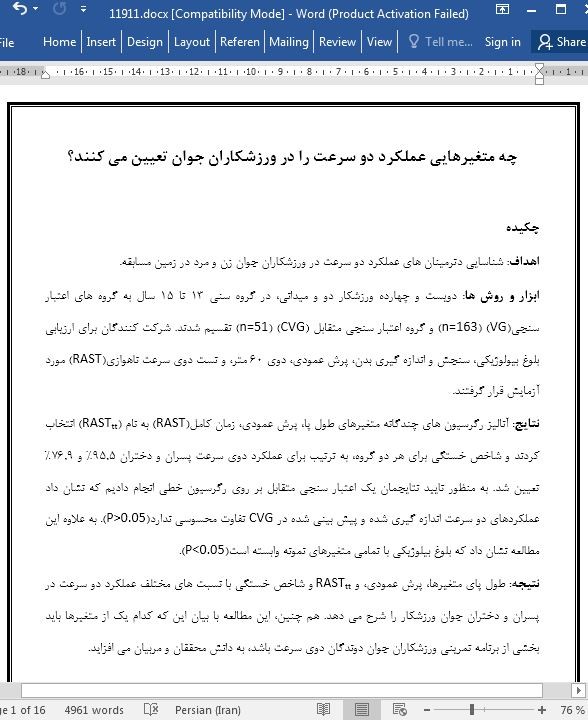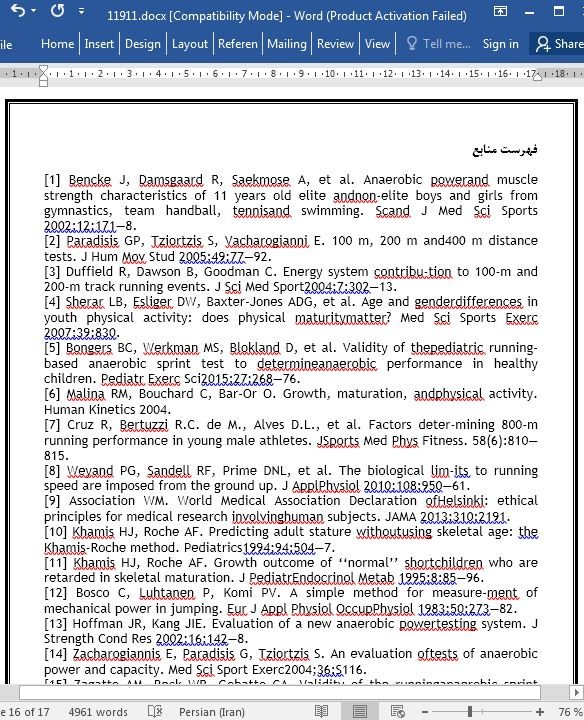
چه متغیرهایی عملکرد دو سرعت را در ورزشکاران جوان تعیین می کنند؟
چکیده
اهداف: شناسایی دترمینان های عملکرد دو سرعت در ورزشکاران جوان زن و مرد در زمین مسابقه.
ابزار و روش ها: دویست و چهارده ورزشکار دو و میدانی، در گروه سنی 13 تا 15 سال به گروه های اعتبار سنجی(VG) (n=163) و گروه اعتبار سنجی متقابل (CVG) (n=51) تقسیم شدند. شرکت کنندگان برای ارزیابی بلوغ بیولوژیکی، سنجش و اندازه گیری بدن، پرش عمودی، دوی 60 متر، و تست دوی سرعت ناهوازی(RAST) مورد آزمایش قرار گرفتند.
نتایج: آنالیز رگرسیون های چندگانه متغیرهای طول پا، پرش عمودی، زمان کامل(RAST) به نام (RASTtt) انتخاب کردند و شاخص خستگی برای هر دو گروه، به ترتیب برای عملکرد دوی سرعت پسران و دختران 95.5% و 76.9% تعیین شد. به منظور تایید نتایجمان یک اعتبار سنجی متقابل بر روی رگرسیون خطی انجام دادیم که نشان داد عملکردهای دو سرعت اندازه گیری شده و پیش بینی شده در CVG تفاوت محسوسی ندارد(P>0.05). به علاوه این مطالعه نشان داد که بلوغ بیلوژیکی با تمامی متغیرهای نمونه وابسته است(P<0.05).
نتیجه: طول پای متغیرها، پرش عمودی، و RASTtt و شاخص خستگی با نسبت های مختلف عملکرد دو سرعت در پسران و دختران جوان ورزشکار را شرح می دهد. هم چنین، این مطالعه با بیان این که کدام یک از متغیرها باید بخشی از برنامه تمرینی ورزشکاران جوان دوندگان دوی سرعت باشد، به دانش محققان و مربیان می افزاید.
6. نتیجه گیری
به طور خلاصه، متغیرهای طول پا، پرش عمودی، RASTtt و شاخص خستگی می توانند در یک نسبت متفاوت، عملکرد دوی سرعت برای ورزشکاران هر دو جنسیت را نشان بدهند. اگرچه، بلوغ بیولوژیکی بخشی از مدل پیش بینی نبود، از این جهت که بر روی تمامی متغیرهای پیش بینی شده تاثیرگذار بود باید در نظر گرفته شود. مدل رگرسیون به میزان قابل قبولی متغیرهای تعیین کننده در دوی سرعت برای ورزشکاران جوان هر دو جنسیت را تخمین زد.
Summary
Objectives To identify sprint performance determinants in young athletes in the field in both sexes.
Equipment and methods Two hundred and fourteen track and field athletes, ages between 13 and 15 years old, were divided into validation group (VG) (n = 163) and cross-validation group (CVG) (n = 51). The participants were submitted to biological maturity evaluation, anthropometry, vertical jump, 60-m sprint, and running anaerobic sprint test (RAST).
Results The multiple regression analysis selected the variables leg length, vertical jump, RAST total time (RASTtt) and fatigue index for both groups, determined 95.5% and 76.9% of sprint performance on boys and girls, respectively. To confirm our results, we performed a cross-validation on the linear regression, which showed that the measured and predicted sprint performances in CVG were not significantly different (P > 0.05). In addition, the study demonstrated that biological maturity is associated with all variables of the model (P < 0.05).
Conclusion The variables leg length, vertical jump, RASTtt and fatigue index explain in different proportions sprint performance in young boys and girls athletes. In addition, this study add to knowledge of researchers and coachers, indicating which variables should be part of the training program of young athletes sprint runners.
6. Conclusion
In summary, leg length, vertical jump, RASTtt and fatigue index variables can explain, in a different ratio, performance in sprint running for young athletes of both sexes. Although biological maturity did not form part of the prediction model, it is must also be considered as it had a significant impact on all prediction variables. The regression model satisfactorily estimated the determinant variables in sprint running with young athletes of both sexes.
چکیده
1. کلمات اختصاری
2. مقدمه
3. اصول و روش ها
1.3. شرکت کنندگان
2.3. روش آزمایشی برای حل این مسئله
3.3 روش ها
4.3 آنالیز آماری
4. نتایج
5. بحث و گفت و گو
6. نتیجه گیری
افشای علاقه
قدردانی و تشکر
فهرست منابع
Summary
1. Abbreviations
2. Introduction
3. Materials and methods
3.1. Participants
3.2. Experimental approach to the problem
3.3. Procedures
3.4. Statistical analyses
4. Results
5. Discussion
6. Conclusion
Disclosure of interest
Acknowledgements
References
- اصل مقاله انگلیسی با فرمت ورد (word) با قابلیت ویرایش
- ترجمه فارسی مقاله با فرمت ورد (word) با قابلیت ویرایش، بدون آرم سایت ای ترجمه
- ترجمه فارسی مقاله با فرمت pdf، بدون آرم سایت ای ترجمه



